Temple of the Sacred tooth relic, Kandy is one of the most religious places of Sri Lankan Buddhists. It is situated adjacent to the royal palace complex of the historical kingdom of Kandy. With its artistic, architectural, cultural, and spiritual values, the Temple of Tooth Relic houses the left canine tooth of Lord Buddha.  It can be recognized as a living cultural heritage that carries various cultural and religious practices for a long period.
The historical value of the Temple of the tooth relic
As recorded in history, the sacred tooth relic of Lord Buddha was brought to Sri Lanka during the reign of King Kirti Sri Megahavanna (301-328 AD) by Prince Danta and Princess Hemamala from the kingdom of Kalinga, India. The king enshrined the tooth relic in the present day Isurumuniya Viharaya in Anuradhapura. Since then, the legal guardian of the relic was the rulers of ancient Sri Lanka and it was preciously guarded by them in a special shrine built within the premises of the royal place, wherever the capital was located.
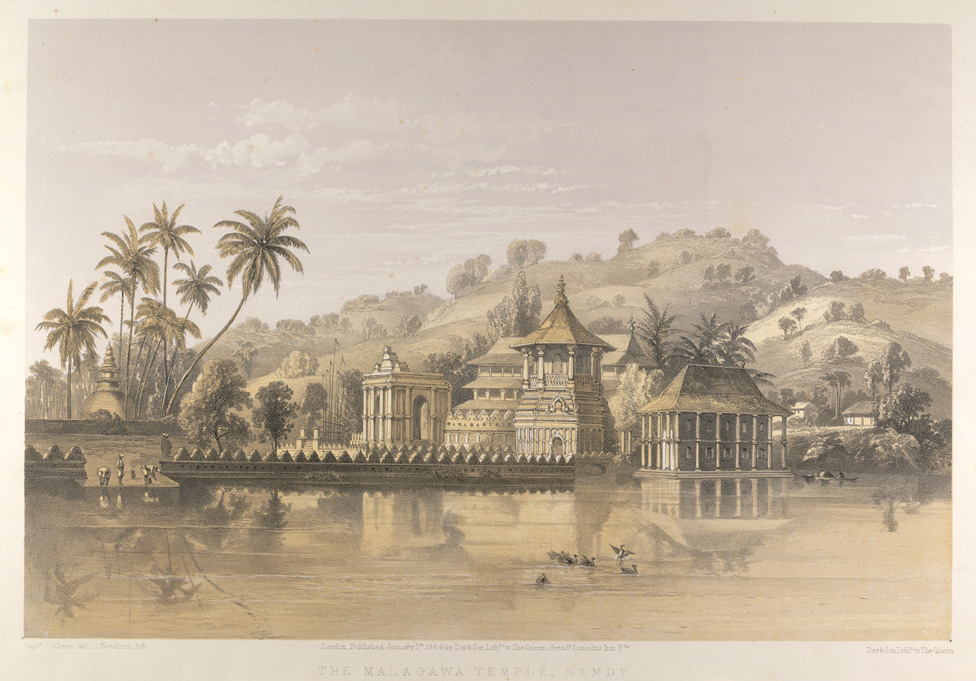
Safeguarding the tooth relic had become a responsibility of the monarch, and it was believed that whoever has custody of it would have the right and power to govern the country. Within the ancient capitals, including Anuradhapura, Polonnaruwa, Dambadeniya, Yapahuwa, Kurunegala, Kotte, and Gampola, the remains of the shrines where the tooth relic has been guarded can be seen. So, throughout the ancient monarchs of Sri Lanka, the tooth relic symbolized both religious value and pollical value.
Kandy, being the last capital of the ancient Sri Lankan monarch, Temple of the Sacred Tooth Relic which we see today is the last place where the sacred tooth rests, after its journey across the capitals of the country throughout a long period. During the reign of King Wimaladharmasuriya I (1592 – 1604 AD), the temple of Tooth Relic was originally built as a two-storied building and it was destroyed during the invasions of the Portuguese. It was rebuilt and modified by King Rajasinghe II (1635-1687 AD) and it was also destroyed and burnt by the Dutch. During the period of King Wimaladharmasuriya II, another temple of tooth relic was built as a three-storied building instead of the old one at the same location.
With the march of time, this building was decayed and destroyed. Later King Parakrama Narendrasignhe (1707 – 1739 AD); the successor of King Wimaladharmasuriya II, constructed the temple of Tooth Relic as a two-storied building which we see today. Afterward, the tooth relic was also safeguarded by the South Indian kings called the Nayakkar kings who ruled Sri Lanka within the same shrine. During the time of King Keerthi Sri Rajasinghe, the temple was finely renovated and remodeled to its present appearance. The last king of the ancient Sri Lankan monarch named King Sri Wickrama Rajasinghe (1798 – 1815 AD) added the surrounding moat and the famous Paththirippuwa or the Octagonal pavilion to the vicinity of the temple from where the king was supposed to have addressed the people. It was believed to be built by Devendra Mulacari, the skilled Architect at the time.
The depository of Tooth Relic during the CÅḷa Occupation of Anuradhapura?
The architectural and artistic value of the temple of the tooth relic
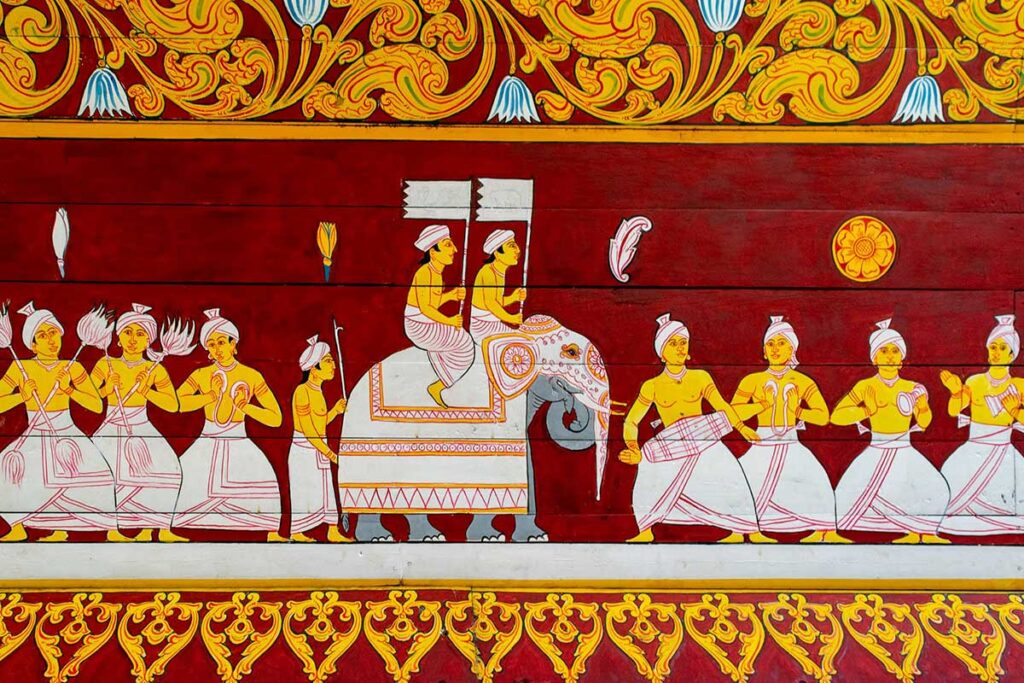
Along with its political and religious value, the architectural and artistic value of the temple of sacred tooth relic should be highlighted since it depicts world-renowned features. The building is constructed in close proximity to the ancient royal palace which is located to the North of the temple and the forest reserve known as Udawatta Kelaya to the East. To the south of the building there is the Kiri Muhuda; the famous Kandy Lake and on the West, there is the Natha and Paththini Devalaya. The temple is adorned with intricate carvings using gold, silver, bronze, and ivory.
The temple of the tooth relic is surrounded by a moat and a brick wall which is named the Wall of water waves or the cloud wall is also a special architectural feature of the Temple of the Tooth. Both were built during the reign of King Sri Wickrama Rajasinghe. The patterned windows on the wall are designed to light lamps at the time.
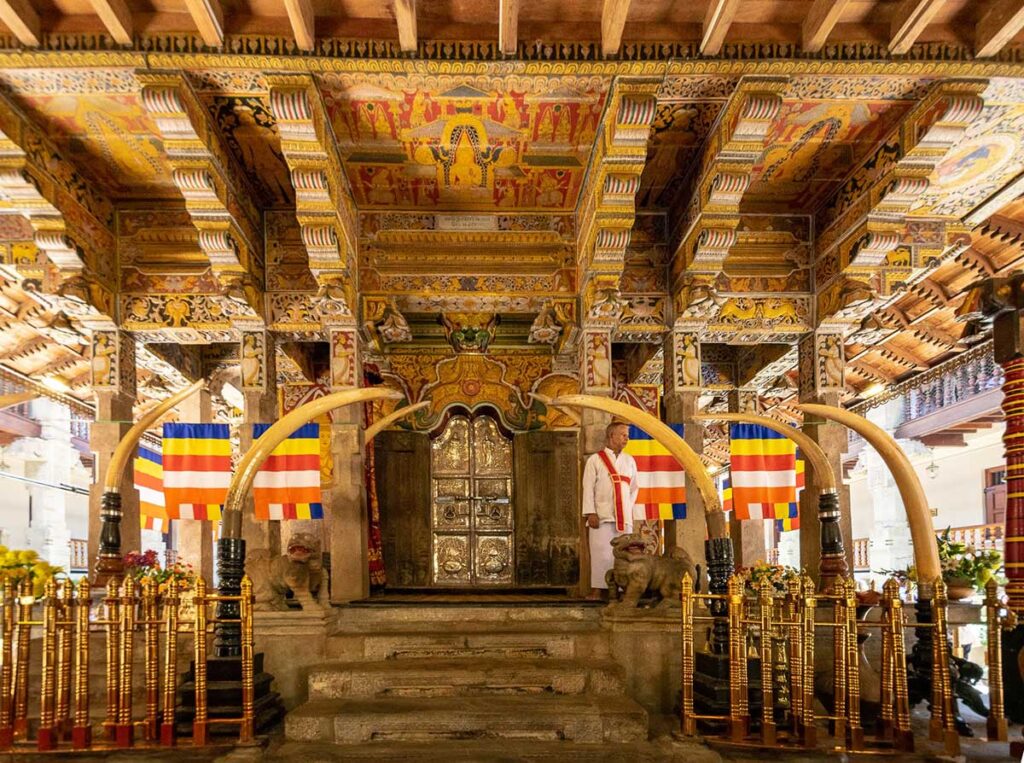
The main entrance called Maha Vahalkada is decorated with a large carved arch with two stone elephants on either side. A moonstone created in the Kandyan architectural style can be noticed at the base of the main entrance steps. This entrance was destroyed due to the bomb blast of L.T.T.E. in the year 1988 and has been renovated afterward along with several stone carvings. At the top of the staircase, there is a Makara Torana with two guardian stones.
The entire temple complex, from peaked tiled roofs to white walls with large windows, is built displaying the style of classical Kandyan architecture. In front of the main building, there is a building named Hewisi Mandapaya or the Drummer’s hall and it can be reached through a tunnel after the main entrance. The main building consists of two stories; the Lower floor is known as Palle Malaya (Lower floor) whereas the upper floor is known as Udu Malaya or Weda sitina Maligawa. The lower floor is comprised of two sections as Digge and Maha Aramudala. The donations made by the kings and the people to the Tooth Relic from time to time are kept in the section called Maha Aramudala.
There are various chambers on the upper floor including the main chamber where the tooth relic is kept known as ‘Handun kunama’. In 1987, a golden canopy was constructed over the main shrine by then Prime Minister Ranasinghe Premadasa, and the golden fence which encircles the main shrine is also a notable feature. The door to that chamber is carved in ivory and inside the chamber there lies the sacred tooth relic on seven gemstone-studded golden caskets which are engraved with precious gemstones. The caskets have the shape of a stupa. The procession casket which is used during the Kandy Esala Perahera is also displayed in the same chamber. The narrow corridor nearby the main chamber is called Kavikara Maduwa where the chanting for the Sacred tooth relic is conducted in this place.
During the 1956 renovations, two-story buildings were erected on either side covering the Wedasitina maligaya. The building on the left is reserved for the functions of Kariya karavana rala, for the alms hall of the monks, and also for the chambers of the monks who are in charge of the service. The other building is reserved for the use of the Diyawadana Nilame and other officers.
Exhibiting the artistic features of the Kandyan period, the insides of the shrine are covered in beautifully detailed and elaborate paintings. King Keerthi Sri Rajasinghe entrusted the task of creating the paintings of the Temple of the Tooth to Hiriyale Hithara Naidu. In 1973, these paintings were redecorated by Cyril Sittara. In addition to these designs, the other architectural feature of the Temple of the Tooth is the wooden pillars. These are made with central ridges and have shapes unique to the Kandyan period. The pillars of the tower are decorated with various carvings. The inside of the temple is more beautified with low curved ceilings of corridors and paved floors with their stones polished. Devendra Mulachari, a renowned architect at the time, has completed the layout of the Temple of the Tooth in a very skillful manner.
In addition to the main shrine, there are other monumental buildings on the premises of the temple of the tooth relic. The royal palace is situated to the north of the temple and as the main entrances, there were three Vahalkadas and an 8 feet high wall used as main entrances. The section of the palace facing the Natha Devale is said to be the oldest. Today the building is preserved as an archeological museum. Ulpen Ge and Queens Palace are the associated buildings of the palace. During the beginning of the British period, it was used by a government officer named Sir John D’Oyly, of Kandy, and later it has been continued to use as their official residence by the successors of D’Oyly.
The audience hall or Magul maduwa is where the Kandyan rulers have held their meetings. It was completed during the reign of Sri Wickrama Rajasinghe. The carvings of the wooden pillars which support the wooden roof are an example of intricate wood carving during the Kandyan period. The hall was renovated for the reception of the arrival of Albert Edward, Prince of Wales in 1872. Originally the hall was 58 by 35.6 feet (17.7 m × 10.9 m); after renovation, its length was extended by an additional 31.6 feet (9.6 m).
Other nearby buildings to the halls were believed to be destroyed during the British rule. The audience hall was the venue where the Kandyan Convention was drawn up, it was where the convention was read out to the people and where the conference, about the convention, was held on 2 March 1815. That space was later used to erect the Kandy Kachcheri and Kandy Supreme Court. Today it is used for state ceremonies and conserved under the Department of archaeology.
A living cultural heritage
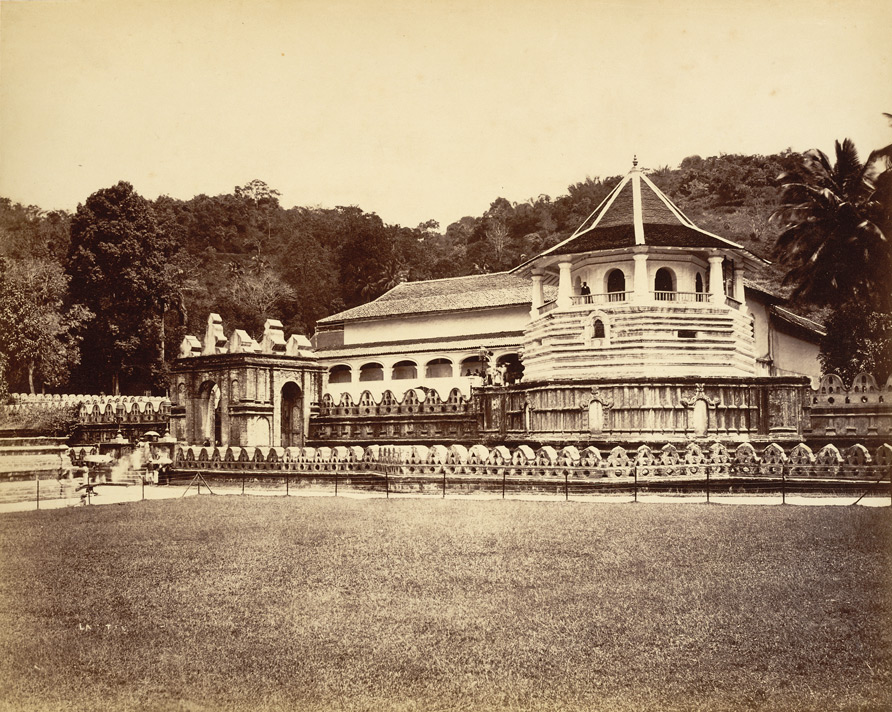
The Sacred Tooth Relic is being considered and worshipped as the living Lord Buddha and for this very reason, Buddhist people have utmost devotion towards it. There are daily, weekly and annual poojas and rituals conducted in order to worship the Sacred tooth relic. Monks of Malwatte and Asgiriya conduct daily worships which are commonly named as Dalada thevava in the inner chamber of the temple. The service held here is exchanged between the Asgiri and Malwathu monasteries once a year. Services are symbolized by the Hewisi Nada Pooja, which is held three times a day at the Hewisi Mandapaya. Rituals are performed three times daily: at dawn, at noon, and in the evenings. On Wednesdays, there is a symbolic bathing of the relic with an herbal preparation made from scented water and fragrant flowers called Nanumura Mangallaya.
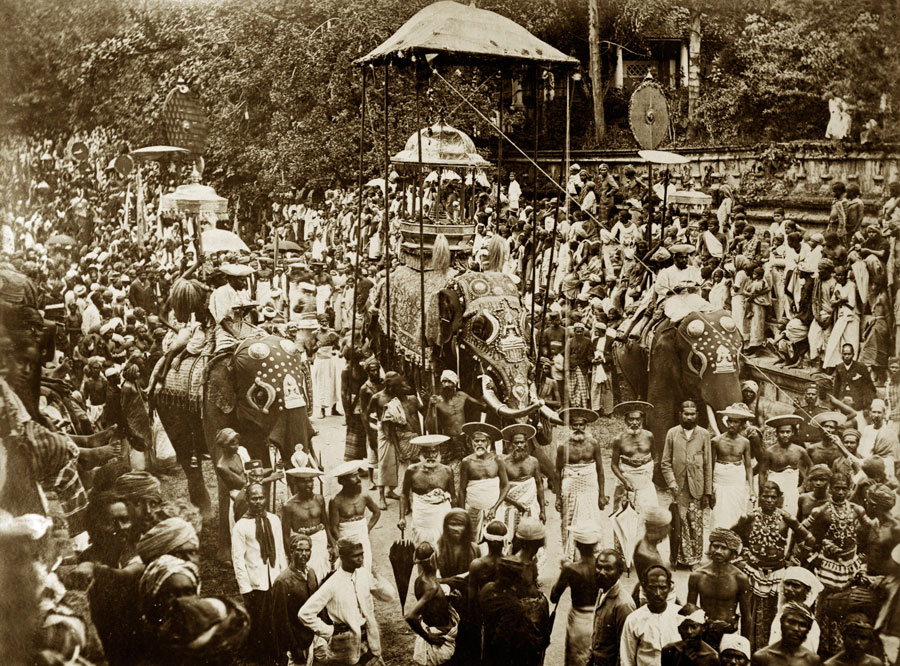
Among the rituals conducted, the procession of the sacred tooth relic of the Dalada Perahera, famously known as the Kandy Esala Perahera held in the month of Esala (July) annually can be highlighted as the main ritual. At the very outset, with the arrival of the sacred tooth relic, it was honored and worshipped with Dalada Perahera by King Kithsirimewan. The procession was then performed as an annual event during the Anuradhapura kingdom with the expectation of timely rain and good harvest. It is considered the epitome of the country’s Buddhist celebrations and it has continued over a long period along with Sri Lankan Buddhist cultural practices and traditions. This is considered to be the oldest cultural event in the world and continues with its colorful and glamourous experience.
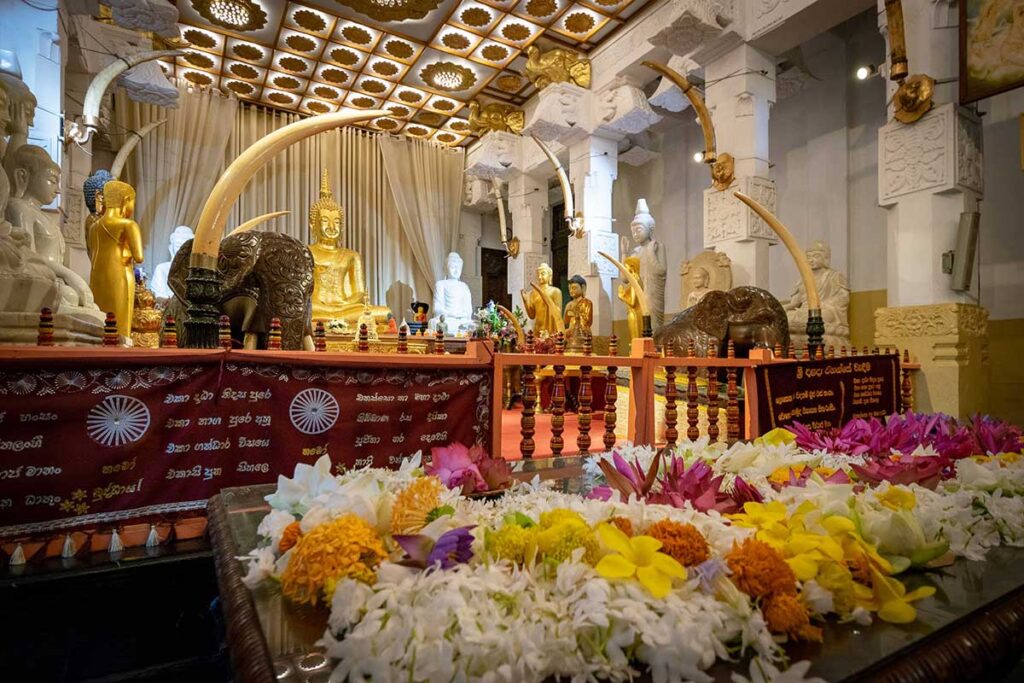
In the present day, the chief custodians of the Tooth relic are the chief monks or the Mahanayake theros of Malwatta and Asgiriya chapters; the main two monasteries of the country and the Diyawadana Nilame. Safeguarding the Sacred tooth relic and conducting the religious rituals that have been continued since the past are being carried out to the present day with the blessings and advice of these chief monks and the Diyawadana Nilame acts as the lay guardian. Over the years, the two monasteries are of significance concerning the guardianship of the Sacred tooth relic, and both play equal roles in the religious activities of the temple of tooth relic.
Being a living cultural heritage site in Sri Lanka, the Temple of the Sacred Tooth Relic is venerated by thousands of both local and foreign devotees every day. Due to its universal value, the temple was designated as a world heritage site in the year 1988 by UNESCO.


